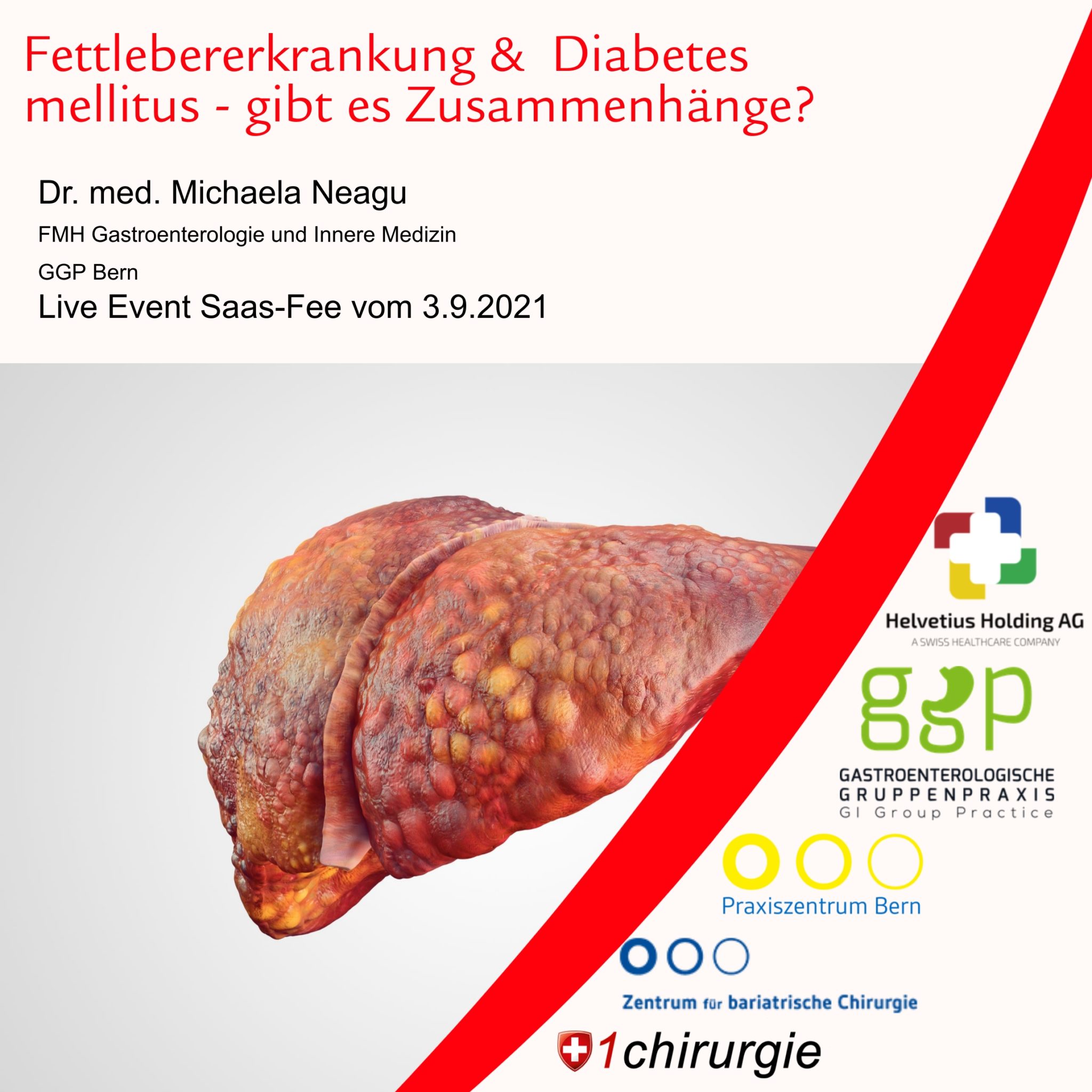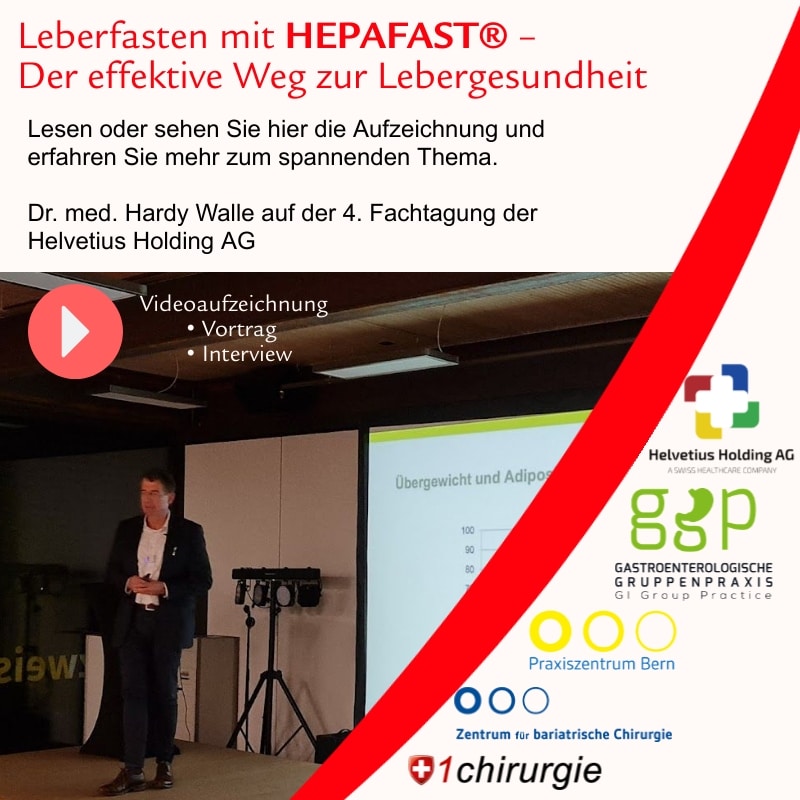
In a lecture by the gastroenterological group practice GGP Bern AG (a company of Helvetius Holding AG), the gastroenterologist Dr. med. Michaela Neagu illustrates the connections between fatty liver and diabetes. Following the lecture, it becomes clear that fatty liver and diabetes form a vicious circle in which both diseases trigger and drive each other. In addition to diagnostics and the effects on overall health, the lecture also opens up a clear picture of how the course of the disease can be successfully influenced and, in the best case, reversed. We have made the lecture by Dr Michaela Neagu available in text form, but also as a video lecture and as a PowerPoint presentation. You can find out more here.
Chapter selection : Start video Select menu bar at the bottom right or dots  !
!
Full screen : Start video Select menu bar bottom right and  !
!
Fatty liver disease and diabetes mellitus – are there correlations?
The experts at Helvetius Holding AG clarify
In a lecture by GGP Bern AG, Dr. med. Michaela Neagu presented the connections between fatty liver disease and diabetes mellitus. This is less about medical jargon and more about educating people about what a fatty liver is, what it means for people’s lives and whether there is a connection to diabetes mellitus.
Dr Michaela Neagu is a specialist in gastroenterology (gastrointestinal diseases) and general internal medicine in the Gastroenterology Group Practice Bern, a partner of Helvetius Holding AG, and has extensive experience and expertise in her specialist field.
In her lecture, Michaela Neagu, MD, highlights the clear connections between fatty liver and diabetes mellitus.
The fatty liver disease

Basically, a distinction is made between alcoholic fatty liver disease and non-alcoholic (metabolic) fatty liver disease. As the different names suggest, one form of fatty liver disease is related to excessive alcohol consumption, the other has nothing to do with alcohol consumption. In addition, there are manifestations such as viral liver diseases, autoimmune diseases, iron storage disorders and other conditions that promote fatty liver disease or make it possible in the first place.
Worldwide, about 25 percent of the population is affected by fatty liver disease. This makes fatty liver the most common liver disease of all. Among diabetics themselves, about 30 to 40 percent have a fatty liver. Also, about half of patients with severe dyslipidemia suffer from fatty liver disease.
How does a fatty liver develop?
A fatty liver occurs when the capacity of the liver cells to absorb fat is exceeded. This causes fat to be deposited in the liver itself, which can no longer be broken down by the liver. The accumulation of fat in the liver cells causes these cells to become inflamed and then send out messenger substances that inhibit the supply of insulin to the liver. Eventually, a kind of insulin resistance develops, so that insulin cannot work in the body as nature intended.
As a result, hyperglycaemia occurs in the body. This sends out a stimulus that causes even more insulin to be produced. The increased insulin level then further leads to increased fat absorption, fat synthesis and fat storage as well. This creates a cycle of action that deposits more and more fat in the liver, but also generally increases fat storage in the body far beyond normal levels.
What do people affected by fatty liver notice?
It is sobering to note that about half of all those affected live practically asymptomatic and accordingly do not worry at all about their liver health, for example. On the one hand, this may have a calming effect, but on the other hand, it is an alarm signal that effective therapeutic interventions only start late, usually very late.
Some patients experience general but rather non-specific fatigue. A certain faintness and perhaps once undifferentiated slight pain in the upper abdomen indicate that a serious condition could be present here. Mostly, however, this is not taken seriously by the patients themselves.
As a result, in most cases the fatty liver remains an incidental finding that only comes to light during the treatment of other diseases. This could be, for example, elevated liver values during a health check or visible changes in the liver during a standard ultrasound examination.
In general, there is a risk that untreated fatty liver can progress to cirrhosis. At the latest then, those affected realise that their liver is sick. Typical signs are then the well-known large water belly, certain bypass circuits in the organism and other signs come very late, however. In practice, everything is possible with the clinical picture of fatty liver, from no symptoms to severe and dangerous courses of the disease.
Between 50 and 90 percent of people with fatty liver are obese, i.e. clearly overweight. Signs of a metabolic syndrome are recognisable.
How can a fatty liver be diagnosed with certainty?
A few years ago, biopsy was the method of choice when the condition of the liver cells needed to be determined more precisely. To do this, a needle is inserted directly into the organ and a small tissue sample is taken. This tissue sample can then be further examined for fatty liver cells.
Thanks to advances in medical technology, we can now diagnose fatty liver without a biopsy in 90 percent of cases. With different imaging methods such as ultrasound or computer tomography, absolutely painless examinations can be carried out today without interfering with the body. Thanks to the excellent presentation, the fat content in the liver can be determined comparatively well with reliable values.
The basis for the evaluation of the ultrasound examinations is, for example, a comparison of liver and kidney tissue. If both organs are healthy, they have approximately the same structure and colour in the image. If the kidney tissue appears darker than that of the liver, then the lighter parts in the liver indicate fat deposits. In this way, a fatty liver can already be recognised with a fairly high degree of certainty.
If the specialists then decide to take a tissue sample, usually to exclude or detect additional liver diseases, the differences become even clearer. A healthy liver consists of neatly arranged and clearly differentiated cells. In fatty liver, the disturbance of the cell architecture due to the fatty deposits is clearly visible. This becomes even more obvious in the case of a pronounced fatty liver with infected cells.
What is the path to fatty liver
From a healthy liver to a fatty liver always takes time and certain circumstances. Various unfavourable factors cause fat storage in the liver cells, which can then further lead to infection in the liver itself. It doesn’t have to be, but it can be. However, when such an infection takes place, a certain remodelling in the connective tissue is driven forward, which can lead to complete scarring of the liver if left untreated. Then the stage of liver cirrhosis has already been reached. Liver cirrhosis, in turn, is a favourable factor for the development of liver cancer. This applies to about two percent of those affected. But even when liver cirrhosis has not yet been diagnosed, more and more cases of liver cancer in fatty liver are becoming known. And in the USA, fatty liver is now considered the most common reason for liver transplantation.
A look at diabetes mellitus

Usually we are talking about diabetes here. This is diagnosed when chronically elevated sugar levels are found in the blood. The body is over-sugared, so to speak. The factors that cause high blood glucose levels are a reduction in the effect of insulin and, in the course of time, often an insulin deficiency.
Currently, about six percent of the world’s population, including children, are affected by diabetes. In children, type 1 diabetes is mostly observed. With the increase in morbid obesity, also in children, type 2 is also becoming more common. Diabetes can be diagnosed in a very reliable and uncomplicated way in various test procedures.
What does diabetes mellitus mean for people’s lives?
The presence of diabetes mellitus is actually associated with serious risks and consequences for the health and life of those affected. One problem is the damage to the small veins. This mainly affects the kidneys, the retina of the eye and the nervous system. The range extends from relatively mild kidney problems to complete kidney failure requiring dialysis. In the case of retinal diseases, such disorders can lead to blindness due to diabetes mellitus. In terms of damage to the nervous system, there is a loss of certain sensory impressions, which can manifest itself, for example, in patients no longer being able to feel the ground beneath their feet. Problems with coordination and spatial position change are also observed. Gastrointestinal disorders with diarrhoea and other symptoms are also reported. Cardiac arrhythmias can complete the picture.
In addition to damage to the small veins, damage to the large veins is also a consequence of diabetes mellitus. Particularly worth mentioning here are coronary heart diseases. At least here, the risk of diabetes patients is significantly higher compared to the normal population. For diabetics, this risk can be assessed as about twice as high. A full 75 percent of diabetics die from a cardiovascular event.
The risk of suffering a stroke is also about 2.5 times higher than in the comparison group of people without diabetes. A circulatory disorder, especially in the legs, has a risk of 4.5 times more than in the comparison group. The diabetic foot is well known, which is caused by precisely these circulatory disorders and can even lead to the necessary amputation.
Diabetes mellitus also generally increases the risk of infection in relation to practically all infectious diseases.
The relationship of fatty liver and diabetes mellitus
What is special about the relationship between fatty liver disease and diabetes mellitus is the fact that both diseases can be mutual and reciprocal triggers as well as consequences of the other disease. This means: fatty liver patients are or often become diabetics and diabetics often suffer from fatty liver. So there is a causal relationship between fatty liver and diabetes.
Let us imagine a possible course of events: An initially physically completely healthy and normal person begins to gain weight for various reasons. Fat tissue increases and at some point the ability to store fat is exhausted. This then leads to a veritable flooding of the entire organism with free fatty acids. At some point, the organism becomes resistant to the effect of insulin and hyperglycaemia occurs. Now the question arises: Where to put the sugar?
Some of the free fatty acids are deposited in the liver cells, where they lead to the fatty liver already described. This significantly limits the liver’s ability to metabolise healthy fats. In addition, there is an increasingly pronounced insulin residual tendency, which in turn affects blood sugar in the interaction and ultimately leads to type 2 diabetes. Other effects are always included here, such as high blood pressure, disorders of the function of the pancreas, etc.
The mutual condition of fatty liver and diabetes creates a vicious circle that is difficult to break, and then only with radical methodology.
What can be done?
At least up to a body mass index BMI of 30, maximum 35, it is still possible to take countermeasures and something should be done actively. It is worth noting that the fatty liver is reversible, i.e. it can also be regressed. Even if liver infection has already occurred, the process can still be reversed. Timely action is crucial. If cirrhosis of the liver has already occurred, it can hardly be stopped. Nevertheless, even then, consistent lifestyle adjustments and regular check-ups should be aimed at preventing further liver damage.
The way back to a healthy liver is always through a reduction in body weight and a corresponding reduction in the over-fatness of the organism. Even a five percent reduction in body weight leads to a relevant defatting of the liver.
With seven to ten percent weight loss, infections in the liver or incipient scarring of the liver tissue can also be reversed. These are encouraging facts that have been sufficiently tested and researched.
Several factors are crucial for weight loss. This starts with a significant reduction in calorie intake and continues with healthy and regular exercise. A period of at least eight weeks, but usually considerably more, is to be set. The closest possible consultation and care by specialists is highly advisable, as other risk factors must also be observed and ruled out. This applies especially to cardiovascular risks.
Toxic foods such as alcohol, drinks with a high fructose content and nicotine should be avoided at all costs.
You can watch the entire lecture by Dr. med. Michaela Neagu with a lot of additional interesting information and further questions and answers here in the video lecture.
A PowerPoint presentation on the topic illustrates and complements the lecture.





